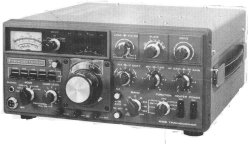
A couple of years ago I bought a second hand (-or perhaps third hand?)
Kenwood TS-820. I wasn't really looking for anything fancy, just a basic
transceiver for HF, that I could bring along to our family's vacation
cottage in Sweden.
The build-in power supply, the tube final that could load up on temporary
antennas, the low price - all matched my requirements perfectly.

But having aquired the station, one of my friends - OZ4VW, Arne - made me
aware of an article from QST February 1983 "WARC Bands for the TS-820" by
W3VT.
The article describes in great details the modifications needed to include
the then new 10MHz, 18MHz and 24MHz bands, into the original 6-band transceiver.
So I decided to go ahead and do the modifications.
Except for the 3 new x-tals for the PLL systems, all other parts - or substitution
parts - could be found in the junkbox. That's one of the great things
about modifying old rigs!
As I did the modifications in steps, it took me about 5 evenings before I was
finished. It can be done more quickly, but I wanted to do a proper job.
The QST article is pretty accurate to follow, but I found a few misprints:
On page 41 "18-MHz Modifications" second paragraph "VCO board" should read
"PD board". On page 42 "24-MHz Modification" first paragraph "34.5 MHz crystal (X9)"
should read "35.0 MHz crystal (X10)".
Apart from that, the only (slightly) difficult thing was the rearranging of wires
in the PA compartment. But the article explains this very well.
Results: - when the station first came to life after the modification and showed
"10.125.0 MHz" in the display, my imminent thought was "by God - it did have the band
inside! - and now I've made it surface".
The performance on the new bands are almost identical to the original. I cannot measure
any difference in receiver sensitivity. Output from the transmitter is higher on 10 MHz
than any other band - even with my worn down final tubes I get 115W output. However on
18 MHz, due to the low LC-ration of the unchanged PA tank, I can get only abt 50-55W
output and with much reduced efficiency. The anode current is almost reaching 300 mA!
So tuning with constant carrier on 18MHz must be done with care not to stress the
finals too much. However for SSB operation it works fine, and the 3dB reduced output
still will make a lot of QSO's for you.
Any comments? - write me an e-mail